-
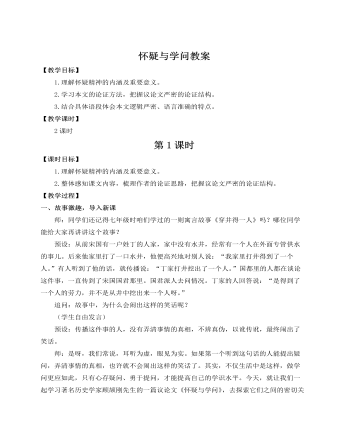
人教部编版语文九年级上册怀疑与学问教案
1.理解怀疑精神的内涵及重要意义。2.整体感知课文内容,梳理作者的论证思路,把握议论文严密的论证结构。【教学过程】一、故事激趣,导入新课师:同学们还记得七年级时咱们学过的一则寓言故事《穿井得一人》吗?哪位同学能给大家再讲讲这个故事?预设:从前宋国有一户姓丁的人家,家中没有水井,经常有一个人在外面专管供水的事儿。后来他家里打了一口水井,他便高兴地对别人说:“我家里打井得到了一个人。”有人听到了他的话,就传播说:“丁家打井挖出了一个人。”国都里的人都在谈论这件事,一直传到了宋国国君那里。国君派人去问情况。丁家的人回答说:“是得到了一个人的劳力,并不是从井中挖出来一个人呀。”追问:故事中,为什么会闹出这样的笑话呢?(学生自由发言)预设:传播这件事的人,没有弄清事情的真相,不辨真伪,以讹传讹,最终闹出了笑话。
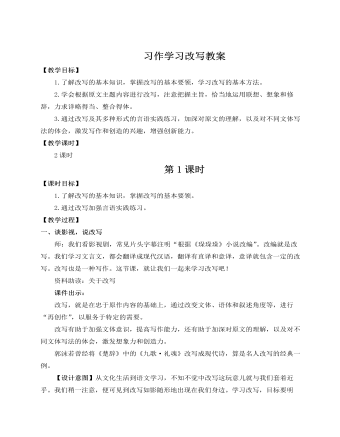
人教部编版语文九年级上册写作学习改写教案
有一天正午正走在黄泥冈上,他们又要喊歇,我自知这一带劫匪出没甚多,便催促他们快走,可他们却坐在地上不动了,任凭我怎样拿鞭抽打,他们也不起来,无奈之下,只得让他们歇会儿。不一会儿,来了一个卖酒的人过来,有人要买酒。被我阻止了,我说这酒里不知放了什么,还是不要喝的好。又一会儿来了几个贩枣的客商,先买了一桶酒,又把另一桶打开喝了一瓢。另一个客人见了,也拿瓢来舀酒。卖酒的见了,抢过瓢来,劈手将酒倒在桶里。殊不知,就在这时,蒙汗药被放进了桶里。老总管过来问我:“杨提辖,你看他们喝了都没事,我们也渴了,就买点吧。”我思量着,这一桶也被喝过,应该没事,只得同意了。于是他们便冲上去买酒,有人还给了我一瓢,我接下来喝了。这时我看他们一个个都头重脚轻栽倒在地上,心里暗叫:不好,中计了。但再想站起来,已经不可能了,看见那群“商人”,一个个笑着,我真是懊悔,没让队伍继续走,还有那些不听我话的人,为什么不听我话,又一次任务失败了,回去怎么交代……不一会儿我眼前一片漆黑,什么也不知道了。醒来后,周围一个人也没有,而生辰纲果然不见了,无奈之下,我只能逃走,却不知何处是终点……
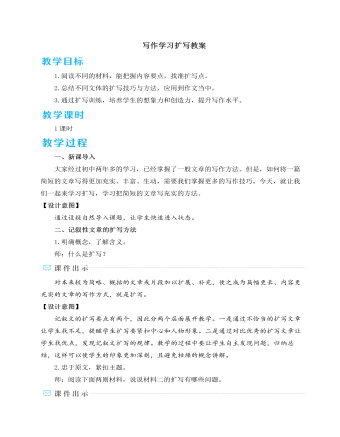
人教部编版语文九年级下册写作学习扩写教案
这一特点还着重体现在动词的应用上面,“鸟宿池边树,僧敲月下门”中的“敲”,就比“推”更能体现诗中以动衬静的特点。在字词上不断推敲,就能体会到诗歌语言高度凝练的特点。再说,古人创作古诗词,并不是写出来的,而是吟咏出来的,他们十分注重音韵在表情达意方面的作用。李清照的《声声慢》便是一个极好的例子,开头“寻寻觅觅,冷冷清清,凄凄惨惨戚戚”十四个叠字,读起来抑扬顿挫,缠绵哀婉,将李清照情绪上的失落、低沉,甚至哽咽展现得淋漓尽致。正因为诗歌的这三个鲜明特点,使得诗歌与别的文体区分开来,具有鲜明的个性。师点评:对于诗歌的扩写,要通过多种方式展现诗歌的主要特点。对诗歌的扩写练习,要求从诗歌意象、语言和节奏韵律三方面展开。首先,这篇习作从三个不同时代的诗歌总结出相同的规律——利用意象表达情感。其次,将古诗词与现代诗进行对比,展现了第二个特点。最后,以《声声慢》为例,详细分析了第三个特点。在紧密围绕诗歌特点的基础上,通过多种方法呈现了对诗歌的认识。
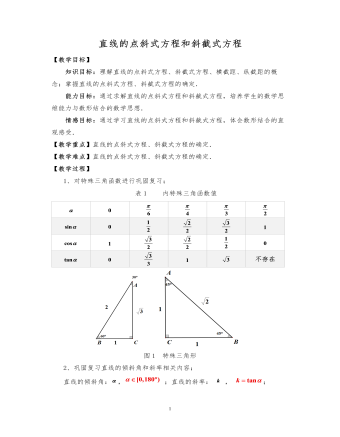
高中数学人教版必修二直线的点斜式方程教案
【教学重点】直线的点斜式方程、斜截式方程的确定.【教学难点】直线的点斜式方程、斜截式方程的确定.【教学过程】1、对特殊三角函数进行巩固复习;表1 内特殊三角函数值 不存在图1 特殊三角形2、巩固复习直线的倾斜角和斜率相关内容;直线的倾斜角:,;直线的斜率: , ;设点为直线l上的任意两点,当时,
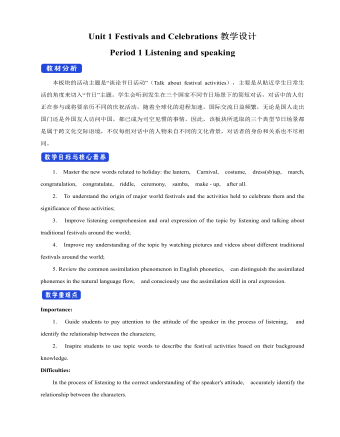
新人教版高中英语必修3Unit 1 Festivals and Celebrations教学设计一
本板块的活动主题是“谈论节日活动”(Talk about festival activities),主要是从贴近学生日常生活的角度来切入“节日”主题。学生会听到发生在三个国家不同节日场景下的简短对话,对话中的人们正在参与或将要亲历不同的庆祝活动。随着全球化的进程加速,国际交流日益频繁,无论是国人走出国门还是外国友人访问中国,都已成为司空见惯的事情。因此,该板块所选取的三个典型节日场景都是属于跨文化交际语境,不仅每组对话中的人物来自不同的文化背景,对话者的身份和关系也不尽相同。1. Master the new words related to holiday: the lantern, Carnival, costume, dress(sb)up, march, congratulation, congratulate, riddle, ceremony, samba, make - up, after all. 2. To understand the origin of major world festivals and the activities held to celebrate them and the significance of these activities;3. Improve listening comprehension and oral expression of the topic by listening and talking about traditional festivals around the world;4. Improve my understanding of the topic by watching pictures and videos about different traditional festivals around the world;5. Review the common assimilation phenomenon in English phonetics, can distinguish the assimilated phonemes in the natural language flow, and consciously use the assimilation skill in oral expression. Importance:1. Guide students to pay attention to the attitude of the speaker in the process of listening, and identify the relationship between the characters;2. Inspire students to use topic words to describe the festival activities based on their background knowledge. Difficulties:In the process of listening to the correct understanding of the speaker's attitude, accurately identify the relationship between the characters.
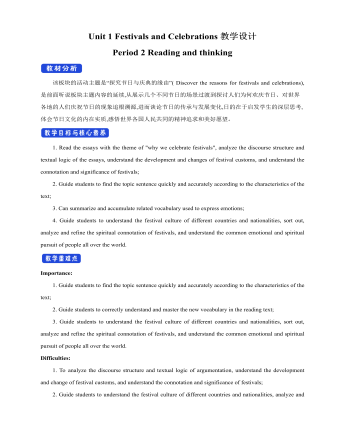
新人教版高中英语必修3Unit 1 Festivals and Celebrations教学设计三
*wide range of origins(= a great number of different origins, many kinds of origins)*It featured a parade and a great feast with music, dancing, and sports. (=A parade and a great feast with music, dancing, and sports were included as important parts of the Egyptian harvest festival.)*.. some traditions may fade away and others may be established.(= Some traditions may disappear gradually, while other new traditions may come into being.)Step 6 Practice(1) Listen and follow the tape.The teacher may remind the students to pay attention to the meaning and usage of the black words in the context, so as to prepare for the completion of the blanks in activity 5 and vocabulary exercises in the exercise book.(2) Students complete the text of activity 5 by themselves.The teacher needs to remind the students to fill in the blanks with the correct form of the vocabulary they have learned in the text.Students exchange their answers with their partners, and then teachers and students check their answers.(3)Finish the Ex in Activity 5 of students’ book.Step 7 Homework1. Read the text again, in-depth understanding of the text;2. Discuss the origin of festivals, the historical changes of related customs, the influence of commercial society on festivals and the connotation and essential meaning of festivals.3. Complete relevant exercises in the guide plan.1、通过本节内容学习,学生是否理解和掌握阅读文本中的新词汇的意义与用法;2、通过本节内容学习,学生能否结合文本特点快速而准确地找到主题句;3、通过本节内容学习,学生能否理清论说文的语篇结构和文本逻辑,了解节日风俗发展与变迁,感悟节日的内涵与意义。

新人教版高中英语必修3Unit 2 Morals and Virtues教学设计四
3.Teachers ask different groups to report the answers to the questions and ask them to try different sentence patterns.The teacher added some sentence patterns for students to refer to when writing.Step 4 Writing taskActivity 51.Write the first draft.Students first review the evaluation criteria in activity 5, and then independently complete the draft according to the outline of activity 4, the answers to the questions listed in the group discussion and report, and the reference sentence pattern.2.Change partners.The teacher guides the students to evaluate their partner's composition according to the checklist of activity 5 and proposes Suggestions for modification.3.Finalize the draft.Based on the peer evaluation, students revise their own compositions and determine the final draft.Finally, through group recommendation, the teacher selects excellent compositions for projection display or reading aloud in class, and gives comments and Suggestions.Step 5 Showing writingActivity 5T call some Ss to share their writing.Step 6 Homework1. Read the passage in this section to better understand the passage.2. Carefully understand the hierarchical structure of the article, and deeply understand the plot of the story according to the causes, process and results;3. Independently complete the relevant exercises in the guide plan.1、通过本节内容学习,学生是否理解和掌握阅读文本中的新词汇的意义与用法;2、通过本节内容学习,学生能否通过人物言行的对比分析道德故事的深层内涵;3、通过本节内容学习,学生能否根据故事的起因、经过和结果来深入理解故事的情节,从而了解文章的层次结构;4、结合现实生活案例发表自己的见解和看法,写一篇观点明确、层次分明的故事评论。
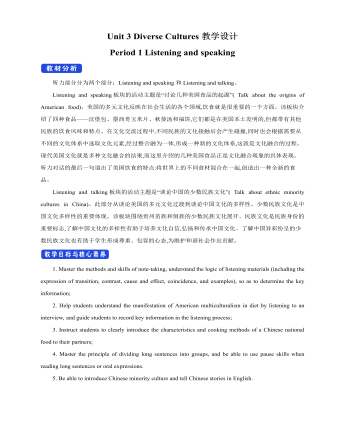
新人教版高中英语必修3Unit 3 Diverse Cultures教学设计一
Activity 81.Grasp the main idea of the listening.Listen to the tape and answer the following questions:Who are the two speakers in the listening? What is their relationship?What is the main idea of the first part of the listening? How about the second part?2.Complete the passage.Ask the students to quickly review the summaries of the two listening materials in activity 2. Then play the recording for the second time.Ask them to complete the passage and fill in the blanks.3.Play the recording again and ask the students to use the structure diagram to comb the information structure in the listening.(While listening, take notes. Capture key information quickly and accurately.)Step 8 Talking Activity 91.Focus on the listening text.Listen to the students and listen to the tape. Let them understand the attitudes of Wu Yue and Justin in the conversation.How does Wu Yue feel about Chinese minority cultures?What does Justin think of the Miao and Dong cultures?How do you know that?2.learn functional items that express concerns.Ask students to focus on the expressions listed in activity. 3.And try to analyze the meaning they convey, including praise (Super!).Agree (Exactly!)"(You're kidding.!)Tell me more about it. Tell me more about it.For example, "Yeah Sure." "Definitely!" "Certainly!" "No kidding!" "No wonder!" and so on.4.Ask the students to have conversations in small groups, acting as Jsim and his friends.Justin shares his travels in Guizhou with friends and his thoughts;Justin's friends should give appropriate feedback, express their interest in relevant information, and ask for information when necessary.In order to enrich the dialogue, teachers can expand and supplement the introduction of Miao, dong, Lusheng and Dong Dage.After the group practice, the teacher can choose several groups of students to show, and let the rest of the students listen carefully, after listening to the best performance of the group, and give at least two reasons.
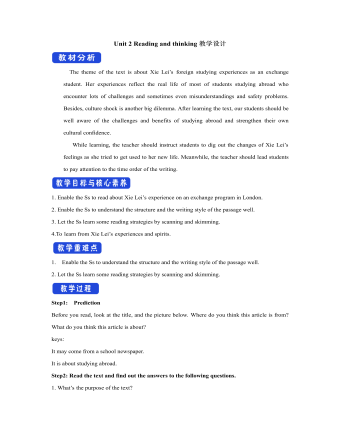
新人教版高中英语选修2Unit 2 Reading and thinking教学设计
Her tutor told her to acknowledge __________ other people had said if she cited their ideas, and advised her _______(read) lots of information in order to form __________wise opinion of her own.Now halfway __________ her exchange year, Xie Lei felt much more at home in the UK. She said __________ (engage) in British culture had helped and that she had been__________ (involve) in social activities. She also said while learning about business, she was acting as a cultural messenger __________(build) a bridge between the two countries. keys:Xie Lei, a 19yearold Chinese student, said goodbye to her family and friends in China and boarded (board) a plane for London six months ago in order to get a business qualification. She was ambitious(ambition) to set up a business after graduation. It was the first time that she had left (leave) home.At first, Xie Lei had to adapt to life in a different country. She chose to live with a host family, who can help with her adaptation (adapt) to the new culture. When she missed home, she felt comforted (comfort) to have a second family. Also Xie Lei had to satisfy academic requirements. Her tutor told her to acknowledge what other people had said if she cited their ideas, and advised her to read lots of information in order to form a wise opinion of her own.Now halfway through her exchange year, Xie Lei felt much more at home in the UK. She said engaging (engage) in British culture had helped and that she had been involved (involve) in social activities. She also said while learning about business, she was acting as a cultural messenger building a bridge between the two countries.
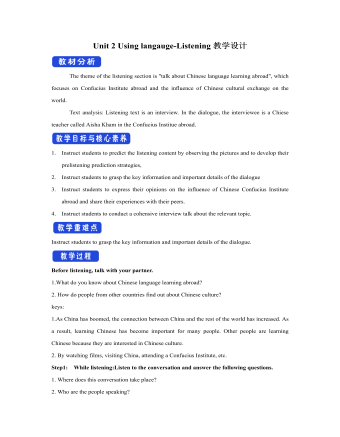
新人教版高中英语选修2Unit 2 Using langauge-Listening教学设计
? B: Absolutely! Getting involved with Chinese cultural activities there definitely helped a lot. I got to practice my Chinese on a daily basis, and I could learn how native Chinese speakers spoke.? A: What do you feel is your biggest achievement?? B: Learning Chinese characters! I have learnt about 1,500 so far. When I first started, I didn't think it was even going to be possible to learn so many, but now I find that I can read signs, menus, and even some easy newspaper articles.? A: What are you most keen on?? B: I've really become keen on learning more about the Chinese culture, in particular Chinese calligraphy. As I have learnt Chinese characters, I have developed a great appreciation for their meaning. I want to explore Chinese characters by learning how to write them in a more beautiful way. ? A: Finally, what do you want to say to anyone interested in learning Chinese?? I have really become keen on learning more about the Chinese culture, in particular Chinese Calligraphy. As I have learnt Chinese character, I have developed a great appreciation for their meaning. I want to explore Chinese characters by learning how to write them in a more beautiful way.? A: Finally, what do you want to say to anyone interested in learning Chinese?? B: I'd say, give it a shot! While some aspects may be difficult, it is quite rewarding and you will be happy that you tried.? A: Thanks for your time. ? B:You're welcome.
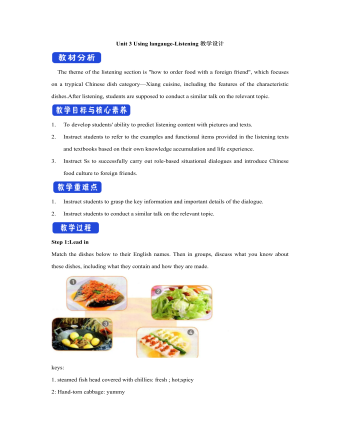
新人教版高中英语选修2Unit 3 Using langauge-Listening教学设计
1. How is Hunan cuisine somewhat different from Sichuan cuisine?The heat in Sichuan cuisine comes from chilies and Sichuan peppercorns. Human cuisine is often hotter and the heat comes from just chilies.2.What are the reasons why Hunan people like spicy food?Because they are a bold people. But many Chinese people think that hot food helps them overcome the effects of rainy or wet weather.3.Why do so many people love steamed fish head covered with chilies?People love it because the meat is quite tender and there are very few small bones.4.Why does Tingting recommend bridge tofu instead of dry pot duck with golden buns?Because bridge tofu has a lighter taste.5 .Why is red braised pork the most famous dish?Because Chairman Mao was from Hunan, and this was his favorite food.Step 5: Instruct students to make a short presentation to the class about your choice. Use the example and useful phrases below to help them.? In groups of three, discuss what types of restaurant you would like to take a foreign visitor to, and why. Then take turns role-playing taking your foreign guest to the restaurant you have chosen. One of you should act as the foreign guest, one as the Chinese host, and one as the waiter or waitress. You may start like this:? EXAMPLE? A: I really love spicy food, so what dish would you recommend?? B: I suggest Mapo tofu.? A: Really ? what's that?
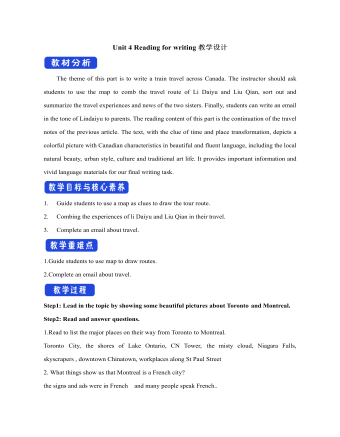
新人教版高中英语选修2Unit 4 Reading for writing教学设计
假定你是英国的Jack,打算来中国旅行,请你给你的中国笔友李华写一封信,要点如下:1.你的旅行计划:北京→泰山→杭州;2.征求建议并询问他是否愿意充当你的导游。注意:1.词数80左右(开头和结尾已给出,不计入总词数);2.可以适当增加细节,以使行文连贯。参考词汇:故宫 the Forbidden City;泰山 Mount TaiDear Li Hua,I'm glad to tell you that 'm going to visit China.First,I am planning to visit Beijing,the capitalof China,where I am looking forward to enjoying the Great Wall,the Forbidden City and somebeautiful parks.Then I intend to go to visit Mount Tai in Shandong Province.I've heard that it is one ofthe most famous mountains in China and I can't wait to enjoy the amazing sunrise there.After that,I amalso going to Hangzhou.It is said that it is a beautiful modern city with breathtaking natural sights,among which the West Lake is a well- known tourist attraction.What do you think of my travel plan? Will you act as my guide? Hope to hear from you soon.

新人教版高中英语选修2Unit 5 Learning about Language教学设计
The purpose of this section of vocabulary exercises is to consolidate the key words in the first part of the reading text, let the students write the words according to the English definition, and focus on the detection of the meaning and spelling of the new words. The teaching design includes use English definition to explain words, which is conducive to improving students' interest in vocabulary learning, cultivating their sense of English language and thinking in English, and making students willing to use this method to better grasp the meaning of words, expand their vocabulary, and improve their ability of vocabulary application. Besides, the design offers more context including sentences and short passage for students to practice words flexibly.1. Guide students to understand and consolidate the meaning and usage of the vocabulary in the context, 2. Guide the students to use the unit topic vocabulary in a richer context3. Let the students sort out and accumulate the accumulated vocabulary, establishes the semantic connection between the vocabulary,4. Enable students to understand and master the vocabulary more effectivelyGuiding the Ss to use unit topic words and the sentence patterns in a richer context.Step1: Read the passage about chemical burns and fill in the blanks with the correct forms of the words in the box.
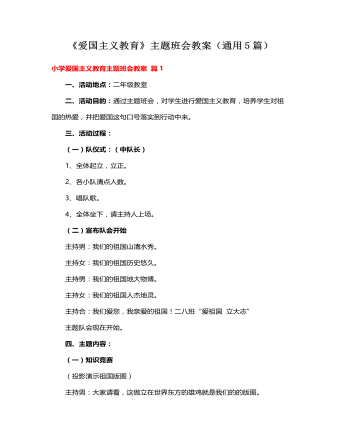
《爱国主义教育》主题班会教案(通用5篇)
我是中国人民的儿子。我深情地爱着我的祖国和人民。爱国主义是千百年来巩固与发展起来的对自己的祖国的一种最深厚的感情。 列宁为什么我的眼里常含着泪水?因为我对这土地爱得深沉! 艾青【第四环节:演唱爱国歌曲】主持人:下面请几位同学为我们展示自己的精彩才艺。演唱一首爱国主题歌曲,让我们在激荡人心的歌声中结束我们这次的主题班会。演唱曲目《爱我中华》主持人:在美妙的歌声中,本次主题班会到此结束。活动小结:通过这次主题班会,激发了学生的爱国情感和民族自豪感,也更加让同学们体会到祖国的发展与强大与同学们是息息相关的,使同学们体会到了肩上所承担的重任让他们明白为什么爱国以及作为学生该如何爱国,将主题班会内容内化到他们的思想中,落实到他们的行动中去。
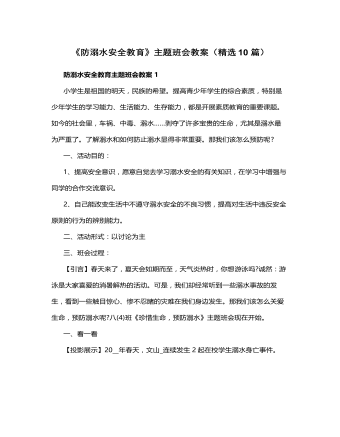
《防溺水安全教育》主题班会教案10篇
(2)如何开展岸上急救教师详细讲解急救步骤:第一步:当溺水者被救上岸后,应立即将其口腔打开,清除口腔中的分泌物及其他异物。如果溺水者牙关紧闭,要从其后面用两手的拇指由后向前顶住他的下颌关节,并用力向前推进。同时,两手的食指与中指向下扳颌骨,即可搬开他的牙关。第二步:控水。救护者一腿跪地,另一腿屈膝,将溺水者的腹部放到屈膝的大腿上,一手扶住他的头部,使他的嘴向下,另一手压他的背部,这样即可将其腹内水排出。第三步:如果溺水者昏迷,呼吸微弱或停止,要立即进行人工呼吸,通常采用口对口吹气的方法效果较好。若心跳停止还应立即配合胸部按压,进行心脏复苏。第四步:注意要在急救的同时,要迅速打急救电话,或拦车送医院。学生按照教师的讲解方法,全班学生每2人分成一个小组,进行模拟演示,1人扮演溺水者,1人扮演救护者。每个小组轮流进行,其他同学细心观察,最后做出总结,指出优点和缺点。
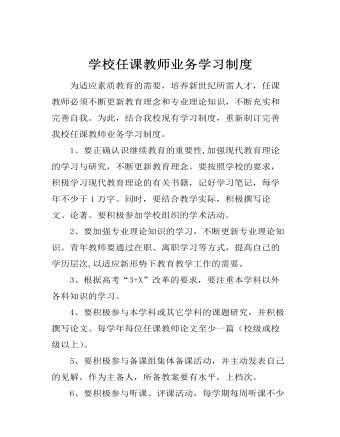
学校任课教师业务学习制度
1、要正确认识继续教育的重要性,加强现代教育理论的学习与研究,不断更新教育理念。要按照学校的要求,积极学习现代教育理论的有关书籍,记好学习笔记,每学年不少于1万字。同时,要结合教学实际,积极撰写论文、论著。要积极参加学校组织的学术活动。 2、要加强专业理论知识的学习,不断更新专业理论知识。青年教师要通过在职、离职学习等方式,提高自己的学历层次,以适应新形势下教育教学工作的需要。
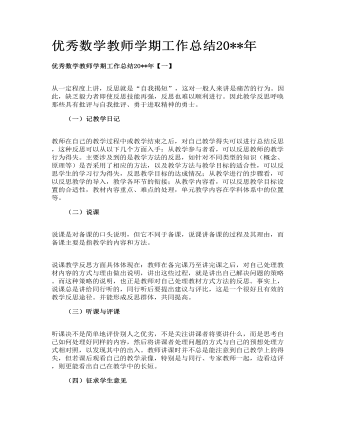
优秀数学教师学期工作总结
(一)记教学日记 教师在自己的教学过程中或教学结束之后,对自己教学得失可以进行总结反思,这种反思可以从以下几个方面入手:从教学参与者看,可以反思教师的教学行为得失。主要涉及到的是教学方法的反思,如针对不同类型的知识(概念、原理等)是否采用了相应的方法,以及教学方法与教学目标的适合性,可以反思学生的学习行为得失,反思教学目标的达成情况;从教学进行的步骤看,可以反思教学的导入,教学各环节的衔接;从教学内容看,可以反思教学目标设置的合适性,教材内容重点、难点的处理,单元教学内容在学科体系中的位置等。 (二)说课 说课是对备课的口头说明,但它不同于备课,说课讲备课的过程及其理由,而备课主要是指教学的内容和方法。 说课教学反思方面具体体现在:教师在备完课乃至讲完课之后,对自己处理教材内容的方式与理由做出说明,讲出这些过程,就是讲出自己解决问题的策略。而这种策略的说明,也正是教师对自己处理教材方式方法的反思。事实上,说课总是讲给同行听的,同行听后要提出建议与评比,这是一个很好且有效的教学反思途径。并能形成反思群体,共同提高。 (三)听课与评课 听课决不是简单地评价别人之优劣,不是关注讲课者将要讲什么,而是思考自己如何处理好同样的内容,然后将讲课者处理问题的方式与自己的预想处理方式相对照,以发现其中的出入。教师讲课时并不总是能注意到自己教学上的得失,但若课后观看自己的教学录像,特别是与同行、专家教师一起,边看边评,则更能看出自己在教学中的长短。
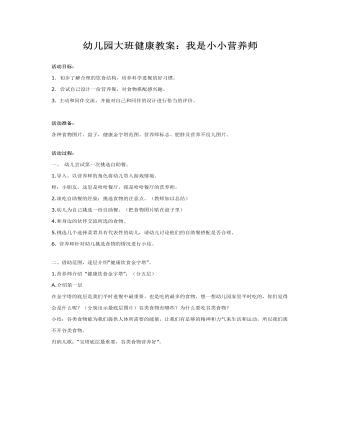
幼儿园大班健康教案:我是小小营养师
活动准备: 各种食物图片、盘子,健康金字塔范图、营养师标志、肥胖及营养不良儿图片。 活动过程: 一、幼儿尝试第一次挑选自助餐。 1.导入。以营养师的角色将幼儿带入游戏情境。 师:小朋友,这里是哈哈餐厅,我是哈哈餐厅的营养师。 2.谈吃自助餐的经验:挑选食物的注意点。(教师加以总结) 3.幼儿为自己挑选一份自助餐。(把食物图片贴在盘子里) 4.和身边的伙伴交流所选的食物。 5.挑选几个选择菜肴具有代表性的幼儿,请幼儿讨论他们的自助餐搭配是否合理。 6. 营养师针对幼儿挑选食物的情况进行小结。
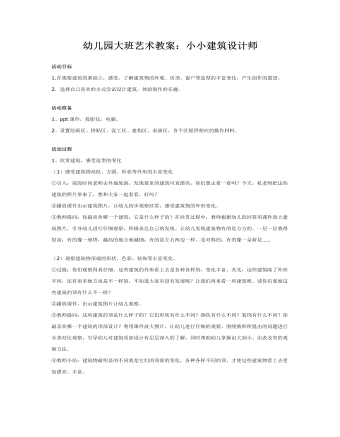
幼儿园大班艺术教案:小小建筑设计师
活动准备 1、ppt课件,投影仪,电脑。 2、设置绘画区、拼贴区、泥工区、建构区、表演区,各个区提供相应的操作材料。 活动过程 1、欣赏建筑,感受造型的变化 (1)感受建筑物高低、方圆、形状等外形的丰富变化 ①引入:前段时间老师去外地旅游,发现那里的建筑可真漂亮,你们想去看一看吗?今天,杭老师把这些建筑的照片带来了,想和大家一起看看,好吗? ②播放课件出示建筑图片,让幼儿初步观察欣赏,感受建筑物的外形变化。 ③教师提问:你最喜欢哪一个建筑,它是什么样子的?在欣赏过程中,教师根据幼儿的回答用课件放大建筑图片,引导幼儿进行仔细观察,积极表达自己的发现。让幼儿发现建筑物有的是方方的、一层一层叠得很高;有的像一座塔,越高的地方就越细;有的是左右两边一样、是对称的;有的像一朵荷花……
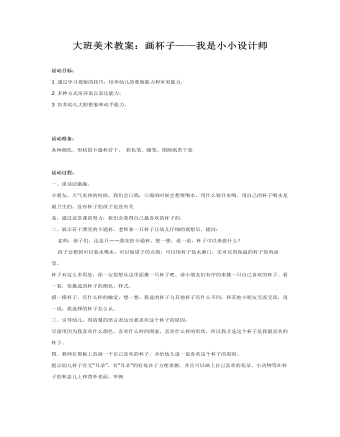
大班美术教案:画杯子——我是小小设计师
活动准备:各种颜色、形状的卡通杯若干、彩色笔、蜡笔、图画纸若干张 活动过程:一、谈话法激趣。小朋友,天气炎热的时候,我们会口渴,口渴的时候会想要喝水。用什么装开水喝,用自己的杯子喝水是最卫生的。没有杯子的孩子也没有关系,通过这堂课的努力,我们会获得自己最喜欢的杯子的。二、展示若干漂亮的卡通杯。老师拿一只杯子让幼儿仔细的观察后,提问: 老师:孩子们,这是只——漂亮的卡通杯。想一想,说一说,杯子可以来做什么? 孩子会想到可以装水喝水,可以做屋子的点缀,可以用杯子装水漱口,还可以用保温的杯子装鸡汤等。杯子有这么多用处,你一定很想从这里面挑一只杯子吧。请小朋友们有序的来挑一只自己喜欢的杯子。看一看,你挑选的杯子的颜色、样式,摸一摸杯子,有什么样的触觉,想一想,我选的杯子与其他杯子有什么不同,和其他小朋友交流交流,说一说,我选择的杯子怎么认。




